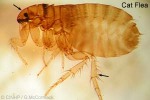Cook Islands Biodiversity Database
Species Page
Ctenocephalides felis
TutuaCat Flea
Multimedia & Additional Resources
| Type | Description | Download |
| Cat Flea - adult | 64KB | |
| Compare: Dog Flea - adult | 70KB |
General Information
Cook Islands Distribution
| Southern Group: Present Makatea: Present | ||||||||
RR |
MG |
AT |
MK |
MT |
AK |
PL |
TK |
MN |
++++ |
||||||||
| Northern Group: Present | |||||
TN |
MH |
RK |
PK |
NS |
SW |
P |
P? |
||||
Pests & Hosts
| Relationship | Hosts |
| Parasite - external | Canis familiaris, Felix catus, Homo sapiens, Rattus rattus, |
Scientific Taxonomy
Ctenocephalides felis (Bouché, 1835)
TAXONOMY: ANIMALIA; ARTHROPODA; ATELOCERATA; HEXAPODA; INSECTA; PTERYGOTA; Siphonaptera; PULICIDAE
More Information
SIGNIFICANCE NOTES -
NEGATIVE SIGNIFICANCE: Pest on cats, dogs, and people. Comments: NBSAP - Te Au-o-Tonga (3 of 11 animal pests)
CONTROL: Remove adult fleas by washing dogs, especially older one, regularly. Use a suitable insecticide. Remove larvae by vacuuming floors and carpets regularly, and by cleaning or replacing the bedding material of dogs and cats. For serious infestations in carpets use a suitable insecticidal spray or fumigant.
GENERAL NOTE: The most common house or domestic flea is the cat flea, Ctenocephalides felis, which is usually the common flea on cats, dogs, rats, and sometimes on people. The Dog flea (Ctenocephalides canis) are uncommon to rare in most countries, although more common in Europe. The two species are distinguished by a slight differences visible under low powered magnification. The female cat flea requires a fresh blood meal to reproduce, and both adults live on continuously on their host.
Life Cycle
The cat flea life cycle has four stages: egg, larva, pupa, and adult. The cycle takes 30 to 75 days, depending on temperature and humidity, and may involve a dormant stage broken by vibration.
The oval eggs, about 0.5mm long, fall off the host. In a couple of days they hatch into 1mm wormlike larvae which live in the host's bedding, in carpets, or in floor-crevices. They feed on organic debris, especially "flea dirt", the dried fecal matter expelled by the adult fleas which is mainly undigested blood from the host. In one or two weeks they are about 5mm and they make a cocoon in which they transform (=metamorphose) into an adult. They remain in the cocoon as an adult until they sense the presence of a host indicated by vibration or an increase in carbon dioxide. The dormant stage can last up to 200 days. This dormancy explains why many fleas appear from carpets after a house as been indisturbed for a long time. Adults live for 1-4 weeks.
The cat flea is an intermediate host of the dog tapeworm, Dipylidium caninum, and an animal (or person) can become infected by this worm only if they swallow a flea. [various sources, GMcC 5/2004]
Vouchers & References
Vouchers:
Rarotonga: "fleas" listed by William Wyatt Gill in 1876; specimens, from dogs, 2000, Maja Poeschko with ID as Ctenocephalides felis. Pukapuka: informant report about fleas on cats, 2/2004, to G.McCormack, probably Ctenocephalides felis.
References:
None recorded.
Data Update History (information):
zTX, zB02, zM04a
Web Resources
Citation Information
McCormack, Gerald (2007) Cook Islands Biodiversity Database, Version 2007.2. Cook Islands Natural Heritage Trust, Rarotonga. Online at http://cookislands.bishopmuseum.org. ![]()
Please refer to our use policy.

